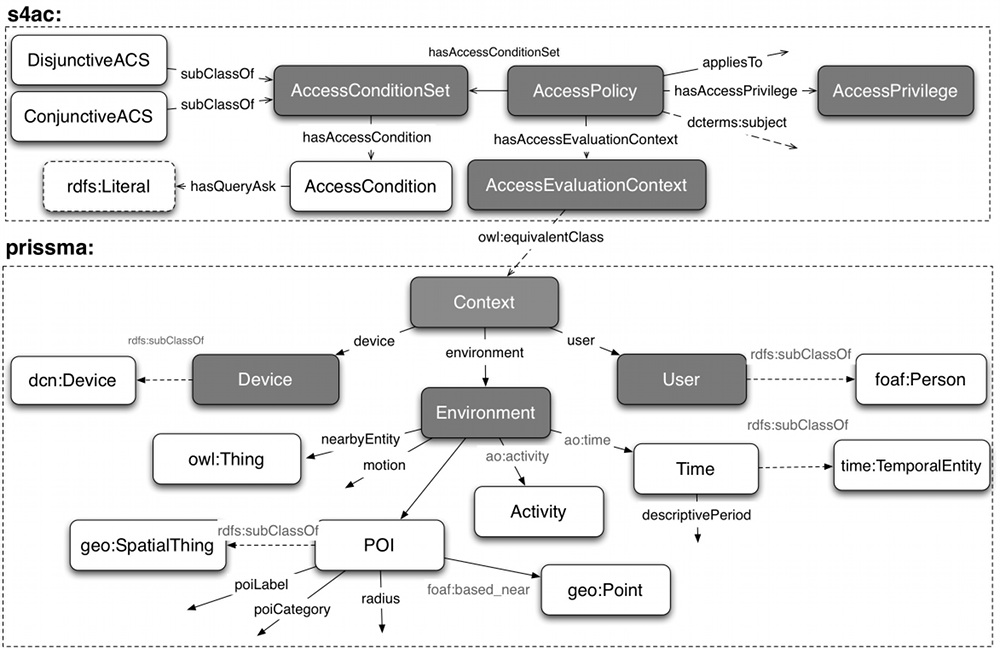
Context-Aware Authorization for Graph Stores
Luca Costabello, Serena Villata, Fabien Gandon, Nicolas Delaforge
In the Web of Data providers expose content publicly, knowing that it is not safe. This may prevent further publication of datasets, at the expense of the growth of the Web of Data itself.
Mobile, ubiquitous Web is continuously evolving, enabling new scenarios in consuming and contributing to the Web of Data. We must therefore not ignore the mobile context in which data consumption takes place.
Shi3ld Access Policy Manager Demo
Direct download (HD, 40.2 MB)
Direct download (SD, 16.7 MB)
Enabling Techs
Named Graphs
The access control model is built over the notion of Named Graph (enforcing permission models is an envisioned use case for RDF named graphs). We rely on named graphs to avoid depending on documents (one document can serialize several named graphs, one named graph can be split over several documents, and not all graphs come from documents). At conceptual level, our policies can be considered as access control conditions over g-boxes (according to W3C RDF graph terminology)
Context Awareness
On-board sensors enable new scenarios in consuming the Web of Data from mobile. The choice and the design of a context model necessarily need a context definition first. We agree on the widely-accepted proposal by A. K. Dey:
"Context is any information that can be used to characterize the situation of an entity. An entity is a person, place, or object that is considered rele- vant to the interaction between a user and an application, including the user and applications themselves."
A. K. Dey. Understanding and using context. Personal and Ubiquitous Computing, 5(1):4–7, 2001.
SPARQL 1.1 Semantics
We protect RDF stores by changing the semantics of incoming SPARQL queries, whose scope is restricted to triples included in accessible named graphs only. We use SPARQL Update language as access primitives, ASK as access conditions. and BINDINGS to contextualize conditions.
Features
Triple-Level Granularity

Data is protected with fine granularity, thanks to RDF named graphs adoption.
Mobile Context in the Loop

Our context-aware access control framework adopts PRISSMA, a lightweight vo- cabulary originally designed for context-aware adaptation of RDF data
Semantic Web Languages Only

We adopt exclusively Semantic Web languages and reuse existing proposals, thus we do not add new policy definition languages, parsers nor validation procedures.
Plug it to any RDF Store

Our proposal has the advantage of being a pluggable filter for generic SPARQL endpoints, with no need to modify the end- point itself.
Model
Our system relies on two complementary lightweight vocabularies: S4AC deals with core access control concepts and PRISSMA focuses on the mobile context.

How it works
Preliminary Step: Policy Definition
Access Policies must be defined as a preliminary step, to protect named grpahs. Each Access Policy is associated to a privilege level and includes a set of context-aware Access Conditions, i.e. constraints that must be satisfied, conjunctively or disjunctively, to access the protected resources.
Example 1
What follows is a sample access policy defined on the named graph:ng1. It allows read access to :ng1 content if the user is located in a given geographic area, with a radius of 500m.
:policy1 a s4ac:AccessPolicy;
s4ac:appliesTo :ng1;
s4ac:hasAccessPrivilege [a s4ac:Read];
s4ac:hasAccessConditionSet :acs1.
:acs1 a s4ac:AccessConditionSet;
s4ac:ConjunctiveAccessConditionSet;
s4ac:hasAccessCondition :ac1.
:ac1 a s4ac:AccessCondition;
s4ac:hasQueryAsk
"""ASK {?context
a prissma:Context;
prissma:environment ?env.
?env prissma:currentPOI ?poi.
?poi prissma:radius "500";
foaf:based_near ?p.
?p geo:lat "43.615811";
geo:long "7.068532".}""".
The above :policy1 protects the named graph :ng1 from read access such as SELECT, ASK (s4ac:Read privilege). The access condition set :acs1 includes only one access condition, :ac1.
The access condition allows access only if the user is located in a point of interest (POI) at given geo coordinates.
1. Query Contextualization
Context data is fetched by mobile sensors. Device, Enviroment and User information is associated to the SPARQL query to protect. This data is saved in the triple store as a named graph.
For further information on how to model context see the PRISSMA vocabulary namespace document.

2. Access Policy Evaluation
The Access Control Manager selects the set of policies affecting the client query, i.e. those with a matching Access Privilege. This is achieved by mapping the client query to one of the four Access Privileges defined by S4AC with the SPIN vocabulary. The Access Conditions (SPARQL ASK queries) included in the selected policies are executed. According to the type of Access Condition Set (i.e., conjunctive or disjunctive), for each verified policy, the associated named graph is added to the set of accessible named graphs .
More info on S4AC access control vocabulary on the vocabulary namespace document.

3. Query Execution
The client query is sent to the SPARQL endpoint with the addition of the FROM clause(s). Query execution is therefore performed only on the accessible named graphs, given the consumer contextual information.
Publications
- L. Costabello, S. Villata and F. Gandon. Context-Aware Access Control for RDF Graph Stores. 20th European Conference on Artificial Intelligence (ECAI 2012) [PDF]
- L. Costabello, S. Villata, N. Delaforge and F. Gandon. SHI3LD: an Access Control Framework for the Mobile Web of Data. 23rd ACM Conference on Hypertext and Social Media (HYPERTEXT 2012), Poster Session, 2012.
- L. Costabello, S. Villata, N. Delaforge and F. Gandon. Linked Data Access Goes Mobile: Context-Aware Authorization for Graph Stores. 5th Linked Data on the Web Workshop (LDOW2012), WWW, 2012 [PDF]
- L. Costabello, S. Villata, N. Delaforge and F. Gandon. Ubiquitous Access Control for SPARQL Endpoints: Lessons Learned and Future Challenges. (WWW2012), Poster session, 2012


